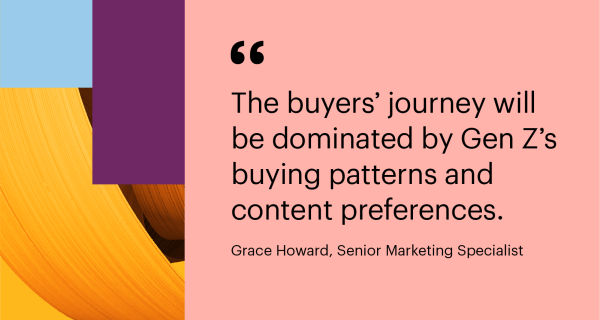Top challenges with ABM / martech stack integrations
As marketers and salespeople, we’re responsible for engaging and converting prospects throughout the buyer’s journey and across platforms. Integrating and leveraging all the different platforms at your disposal is no easy feat when companies on average use between 40 and 200 SaaS applications, spending close to $1M / yr, but luckily there is more opportunity than ever for tech stack integration and the effort is well worth the benefits of a connected team and tech stack.
Whether you already have an ABM strategy in place or are currently evaluating ABM vendors, you’ll want to make sure you are building a martech stack that integrates with critical parts of your technology, marketing, sales, and analytics tools. Let’s look at some top challenges we see with ABM and martech stack integrations.
Challenge #1: Underutilization of stack integrations
With so many applications used daily and constant product updates, the struggle is real to leverage the full capabilities in your martech stack. In fact, Gartner found in its Marketing Technology Survey 2020 that professionals only use 58% of their marketing stack’s full capabilities. Somewhat of an unnerving statistic, especially if you are actively building yours out.
Why are marketers struggling to utilize their tech stacks? New integrations and functionality are being added all the time, making it hard to keep your stack up to date. In order to keep up with technology innovations, it’s important to check in on your stack. You should constantly be looking for new integrations available, and making sure you are leveraging all the integrations / cross-platform functionality that you could be.
What are some other best practices to stay on top of your integrations and get the most out of your stack?
- Audit your martech stack regularly: Evaluate your tech stack’s ROI, and look for areas to downsize or upgrade.
- Talk to your vendors: Don’t be afraid to tell your vendors if you think of functionality or integration opportunities that would help you. A favorable vendor is going to respond as a partner. True vendor partners will help you build up your tech stack as a whole so that your team will be well-equipped to successfully execute towards your goals.
- Raise your hand: Seek out help from other teams, external agency partners, or martech integrators.
Challenge #2: Prioritizing people and strategy
As companies grow and quickly adopt new technology to support their processes, what ends up happening is their martech stacks are built on an as-needed basis. But just like any power tool – martech tools require skilled operators.
Companies often find it easy to turn to the latest tool for a quick fix. But fancy tools won’t solve any of your problems without a set strategy and talented individuals that understand how to align your specific marketing goals with your stack’s capabilities. People and strategy do the real work.
Tech stacks are not the powerhouse behind systems, but a vehicle to efficiently and effectively execute strategy.
Kerri Harrington, Marketing Ops Analyst at Hubspot (a martech power tool itself)
When building out your tech stack, here are a few questions that you might want to pause and ask before purchasing your next tool.
- “Does this tool align with our current strategy?” Make sure the tool you are buying is a part of your long-term strategy and not an impulsive purchase that will go on the back burner in a few months.
- “What are my team’s strengths?” Select tools that pair well with your team’s strengths and past martech experience. Creating an environment where your team can learn and improve is key. Give your team the option to invest in workshops, training courses, or conferences.
- “What tools do we already have? What tools do we need?” Pinpoint very specific needs and pain points that your new technology will solve.
Once you prioritize people and strategy, determine what’s needed to implement new tech stack additions – the time and effort needed to integrate new additions into your tech stack, as well as the bandwidth needed for team members to learn and leverage a new platform. Prioritizing people and ensuring they can and will use new products is key to tech stack success.
Challenge #3: Marketing and sales silos
Silos between marketing and sales arises when teams are not on the same tech stack platforms. When teams are siloed, this leads to confusion across the buyer’s journey – with no platform having a complete view of the buyer’s journey. In successful account-based marketing programs, marketing and sales need to have an open line of communication across technology.
Alignment and cross-functional support are necessary from the very beginning to make account-based marketing truly effective. This requires involvement from an executive sponsor and buy-in from the sales team. Everyone needs to be on the same page about what to expect from the program from the very start.
Andrew Mahr, Chief Customer Officer, SaaS, Foundry
Why is it so important to align your organization with your tech stack? Research from CSO insights shows that sales organizations with less than 75% CRM adoption have noticeably lower win rates and quota attainment. And on the other hand, higher CRM adoption leads to noticeably higher win rates and quota attainment.
Aligning your tech stack to your entire organization is essential to higher win rates and demonstrating ROI to upper management.
Stack success – $9.9M generated in influenced pipeline attribution
The team at SugarCRM was seeking ways to stand out within the competitive CRM market and find the perfect addition to their tech stack that would support their ABM efforts with sales orchestration features. Since implementing an ABM strategy, Sugar has generated $9.9M in influenced pipeline attribution from their ABM efforts, with an estimated $2.8M in the first quarter alone.
The Foundry ABM integration with Sugar and countless other martech tools makes marketing data finally actionable for sales teams. With a high-definition view of account activity, paired with intent data, valuable account insights are visible all in one place. Jason Rushforth, SVP & GM SugarCRM Americas, explains, “We can now use our data elements to build dashboards and reports with Smart Score to create a holistic view for sales directly within Sugar.”
Marketing technology is advancing faster than ever before, making building your perfect martech stack a never-ending process. But with these tips on how to navigate top challenges you’ll be able to get the most out of your tech stack tools. Interested in learning how ABM can help you get even more out of your MarTech stack?






